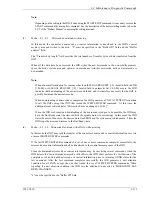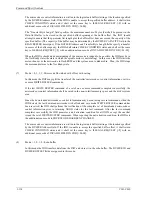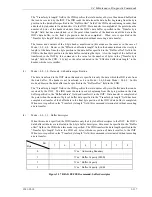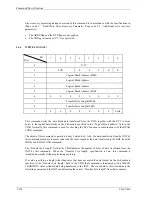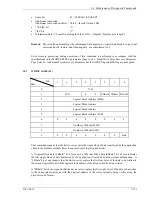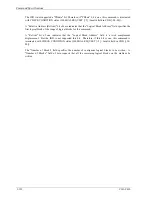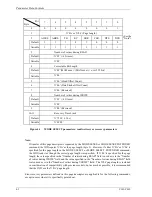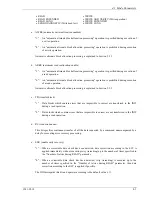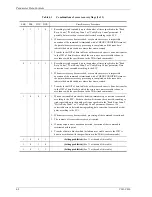
3.4 Maintenance, Diagnostic Commands
C141-C010
3-117
The “Transfer byte length” field in the CDB specifies the total number of bytes of header and buffer data
that can be received by the INIT. The IDD reads the data from the data buffer beginning from the byte
position in the data buffer specified in the “Buffer offset” field of the CDB and continuing in order, then
adds the 4-byte header to it and transfers it to the INIT. Data transfer is completed at the point when the
number of bytes of the header and data from the IDD’s data buffer, specified in the “Transfer byte
length” field, has been transferred, or at the point when transfer of the header and all the data in the
IDD’s data buffer, to the final byte position, has been completed. When zero is specified in the
“Transfer byte length” field, this command is terminated without executing a data transfer.
The format and contents of the 4-byte header transferred in this mode are the same as in the case of
Mode = 0, 0, 0, 0. However, the “Effective buffer data length” field in the header indicates the size (byte
length) of the data from the byte position in the data buffer specified in the “Buffer offset” field in the
CDB to the final byte position in the data buffer, including that byte. Also, the length of the buffer data
transferred to the INIT by this command is the value for the number of bytes in the [“Transfer byte
length” field in the CDB – 4 bytes] or the value indicated in the “Effective buffer data length” in the
header, whichever is smaller.
(3)
Mode = 0, 0, 1, 0: Data only, with address specification
The data transferred to the INIT when this mode is specified is only the data which the IDD reads from
the data buffer. The header is not transferred as it is in Mode = 0,0,0,0 and Mode = 0,0,0,1. In this
mode, address in the data buffer can be specified in the “Buffer offset” field in the CDB.
The “Transfer byte length” field in the CDB specifies the total number of bytes of buffer data that can be
received by the INIT. The IDD reads the data in order beginning from the byte position in the data
buffer specified in the “Buffer address” field and transfers it to the INIT. Data transfer is completed at
the point when the number of bytes of buffer data specified in the “Transfer byte length” field has been
completed or transfer of the buffer data to the final byte position of the IDD’s data buffer is completed.
When zero is specified in the “Transfer byte length” field, this command is terminated without executing
a data transfer.
(4)
Mode = 0, 0, 1, 1: Buffer descriptor
When this mode is specified, the IDD transfers only the 4-byte buffer descriptor to the INIT. the IDD’s
data buffer attributes are indicated in the 4-byte buffer descriptor. Zero must be specified in the “Buffer
offset” field in the CDB when this mode is specified. The IDD transfers the data length specified in the
“Transfer byte length” field in the CDB or 4 bytes, whichever portion of data is smaller, to the INIT.
When zero is specified in the “Transfer byte length” field, this command is terminated without executing
a data transfer.
Bit
Byte
7
6
5
4
3
2
1
0
0
X’xx’ Addressing Boundary
1
X’xx’ Buffer Capacity (MSB)
2
X’xx’ Buffer Capacity
3
X’xx’ Buffer Capacity (LSB)
Figure 3.37 READ BUFFER command: buffer descriptor
Summary of Contents for 80
Page 4: ...This page is intentionally left blank ...
Page 10: ...This page is intentionally left blank ...
Page 18: ...This page is intentionally left blank ...
Page 62: ...This page is intentionally left blank ...
Page 284: ...Sense Data Error Recovery Methods This page is intentionally left blank ...
Page 296: ...This page is intentionally left blank ...
Page 298: ...This page is intentionally left blank ...
Page 308: ...This page is intentionally left blank ...
Page 309: ......
Page 310: ......











